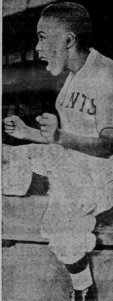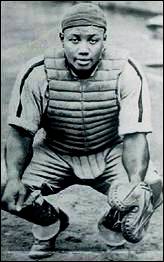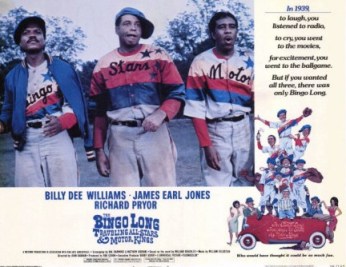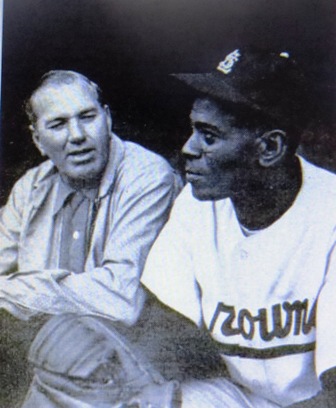After Heywood Broun’s remarks at the 1933 Baseball Writers Association dinner about integrating the game, The Pittsburgh Courier initiated a campaign to push the issue. Despite some support inside baseball and from well-known newspapermen, the effort fell flat by opening day.
That summer, after the first East-West Game—won by the West All-Stars 11 to 7—at Comiskey Park, Henry L. Farrell of The Chicago Daily News suggested several “(M)ajor league club owners who are now on their knees might have their prayers answered,” by signing some the Negro League stars.
In the fall, The Chicago Defender briefly picked up the mantle from The Courier. The paper asked their readers:
“How would you like to see the great baseball players of the Race performing in the major leagues? Wouldn’t you like to see Willie Foster, Satchel Paige and (Sam) Streeter pitch to Babe Ruth?”
If so:
“Sit down and write K.M. Landis commissioner of baseball, 333 N. Michigan Ave., Chicago.”
The following week, the paper reported that Landis’ office had refused to comment. When baseball’s winter meetings commenced in Chicago in December, The Defender promised readers that the letters they had sent:
“(A)re not being passed on lightly as many suggested would be the case. On the contrary, the club owners are downright concerned and from the inside word leaked out that some action would be taken.”
The optimism was tempered later that week when their reporter was barred from covering a meeting where he was told “vital points were discussed.” The Defender reporter was told no newspapermen would be admitted, but:
“That sinister moves were being made against your author’s admission became a certainty when a well-known writer from one of the downtown papers came along, gave the high sign and was admitted.”
When 1933 came to a close, integration was no closer to being a reality than it was 11 months earlier as Broun stood to deliver his remarks to the baseball writers.
Four years later, Sam Lacy from The Baltimore Afro-American met with Washington Senators owner Clark Griffith in an attempt to revive the subject:
“I mentioned Satchel and Josh and Cool Papa, I told him he was missing the boat.”

Sam Lacy
Griffith, he said, told him the timing was wrong, and that Southern-born players would not accept integration.
The next major effort came in 1939.
Political support had generally been limited to socialist and communist organizations—the Young Communist League spent the summer of ’39 gathering signatures to present to Commissioner Landis. But, in July of that year, the Illinois House of Representatives adopted a resolution which read in part:
“Resolved, by the House of Representatives of the Sixty-first General Assembly. That the owners of all professional baseball teams in the United States, both in the major and minor leagues be strongly urged to give baseball players of the colored race the same opportunity of becoming players on their respective teams as is accorded to such players of the white race.”
Another push came from Pittsburgh as well.
Wendell Smith, who was playing baseball at West Virginia State College when Broun made his speech in 1933, was now a reporter for The Courier. In July, he promised readers:
“The most exclusive, startling and revealing expose, of the attitude of the major league players and managers themselves, ever written.”

Wendell Smith
Over the course of several weeks Smith asked 40 players and eight managers as they passed through Pittsburgh, “Are Negro ballplayers good enough to ‘crash’ the majors?”
The Courier’s Chester Washington said in a column to introduce the series of articles:
“One of the major reasons why Mr. Smith’s discovery is so revolutionary is that the club owners, in trying to pass the buck, have blamed the ban on the players themselves. They claimed that the injection of colored stars into the clubs would bring about friction and dissention… (Smith) practically disproves this contention.
“Fearlessly buttonholing the managers and outstanding players of all the National League clubs, Mr. Smith received scores of testimonials which should be a revelation to the owners.”
A sampling of the statements collected by Smith:
Ernie Lombardi, Cincinnati Reds: “(Satchel) Paige is as good as (Dizzy) Dean.”
Johnny Vander Meer, Cincinnati Reds: “I wouldn’t object.”
James “Doc” Prothro, Philadelphia Phillies: “If given permission I would jump at the opportunity to sign up a good Negro ballplayer.”
Leo Durocher, Brooklyn Dodgers: “(Satchel) Paige, (Bill “Cy”) Perkins, (Mule) Suttles and (Josh) Gibson are good enough to be in the majors right now…I certainly would use a Negro ballplayer if the bosses said it was all right.”
Gabby Hartnett, Chicago Cubs: “I am sure that if we were given permission to use them, there would be a mad scramble between managers to sign them.”

Gabby Hartnett
Dizzy Dean, Chicago Cubs: “If some of the colored players I’ve played against were given a chance to play in the majors they’d be stars as soon as they joined up.”
Pepper Martin, St. Louis Cardinals: “Some of the big league players would object, but on the whole I think they would be accepted.”
Pie Traynor, Pittsburgh Pirates: “believe me when I say I have seen countless numbers of Negro ball players who could have made the grade in the majors. Only their color kept them out. If given permission, I would certainly use a Negro player who had the ability.”
Honus Wagner, Pittsburgh Pirates: “Yes, down through the years I have seen any number of Negro players who should have been in big league baseball.”
Over the next five years, Smith would interview more than 150 additional major leaguers, who would echo the sentiments of his original 40, keeping the pressure on professional baseball to desegregate.
Tags: Babe Ruth, Brooklyn Dodgers, Chicago Cubs, Cincinnati Reds, Clark Griffith, Comiskey Park, Cy Perkins, Doc Prothro, Ernie Lombardi, Gabby Hartnett, Henry L. Farrell, Heywood Broun, Honus Wagner, Johnny Vander Meer, Kennesaw Mountain Landis, Leo Durocher, Mule Suttles, Negro Leagues, Pepper Martin, Pie Traynor, Pittsburgh Pirates, Saint Louis Cardinals, Sam Lacy, Sam Streeter, Satchel Paige, Washington Senators, Wendell Smith, Willie Foster


























